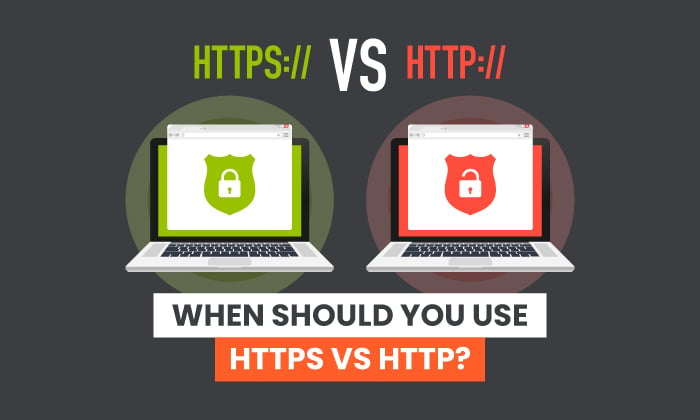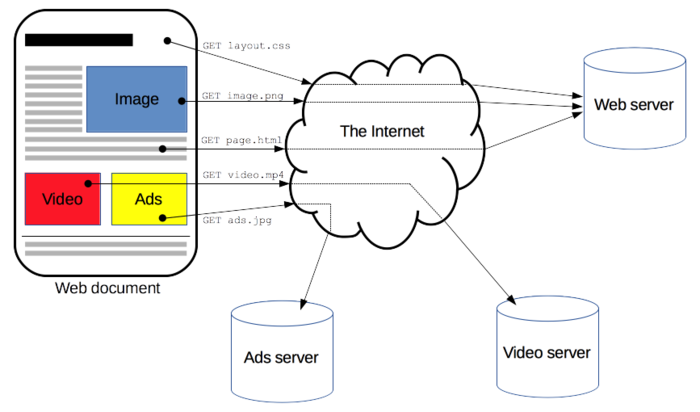
If you run a business website, you’ve probably heard you must make the switch from HTTP to HTTPS. But is there more of a difference than the extra “s?”
As a business owner, you know even the slightest difference in a product, marketing strategy, or anything else related to your business can make a big difference.
But will the switch to HTTPS have a significant impact on your website and business?
After all, some users won’t notice the difference.
Here, we’ll discuss the differences between HTTP and HTTPS and whether you should make the switch.
HTTPS vs. HTTP: What’s the Difference?
Both HTTP and HTTPS are protocols governing how information transmits over the internet. To understand the differences between HTTP and HTTPS, let’s look at each one individually and how it works.
What is HTTP?
HTTP is an acronym for Hypertext Transfer Protocol, an application layer protocol created by Tim Berners-Lee. The protocol provides standard communication rules between web servers and clients (browsers).
The most significant problem with HTTP is it uses hypertext structured text, so the data isn’t encrypted.
As a result, the data being transmitted between the two systems can be intercepted by cybercriminals.
For example, let’s say you visit a website that uses HTTP, and the website requires you to create credentials for logging in. Because the data shared between the servers and your browser isn’t encrypted, hackers can more easily intercept and decipher your credentials.
That’s why search engines like Google now display an open lock icon on web addresses using HTTP. They also show a message stating the website you’re about to visit is unsafe.
Another drawback to HTTP is it can only handle one request at a time.

A complete document is reconstructed from different sub-documents. Multiple requests are needed just to load one web page. Of course, this means load speed can be negatively impacted for large websites and pages.
What is HTTPS?
HTTPS is an advanced version of HTTP which implements an SSL or TLS to encrypt the information transmitted between a server and a client.
SSL is an acronym for secure sockets layer, while TLS stands for transport layer security. Both technologies create a secure encrypted connection between a web server and the web browser it communicates with.
The added layer of security makes Hyper Text Transfer Protocol Secure (HTTPS) the better alternative between the two protocols. This is especially true for websites handling sensitive data, like e-commerce websites or any other site requiring users to login using their credentials.
In short, HTTPS is a more secure version of HTTP.

This safety afforded by HTTPS ensures users’ information is secure in three layers:
- Encryption: This helps ensure a user’s activity can’t be tracked or their information be stolen.
- Data integrity: HTTPS prevents files from being corrupted when transferring between a web server and website and vice-versa.
- Authentication: HTTPS authenticates websites. Authentication helps build trust with users.
As you can see, the differences between HTTP and HTTPS are stark.
HTTPS vs. HTTP: Which is Better for SEO?
I’ll answer this immediately: HTTPS is better for SEO. Here’s why.
HTTPS is Better for Site Security
Security is one of the biggest things search engines look at when ranking websites.
That’s why Google announced HTTPS is one of the ranking signals they use in their algorithm.
This is one of the most significant advantages HTTPS has over HTTP when it comes to SEO.
HTTPS Referral Data is Clearer
Besides the security factor, another SEO advantage you get with HTTPS that you don’t get with HTTP is better insight into referral data. If your website still runs on HTTP and you check your data in Google Analytics (GA), the traffic passing through referral sources can appear as “direct” traffic. With HTTPS, you get a clearer picture of where your traffic is coming from. As a result, you’re in a better position to create more effective SEO strategies.
Using HTTPS Builds Authority
Because browsers like Chrome let users know a website they’re visiting uses HTTP and is therefore not safe, and many visitors leave immediately. This high bounce rate negatively impacts your SEO as it’s a signal of bad user experience (UX). UX is crucial as Google says page experience is one of their major ranking factors.
On the other hand, when visitors visit a website employing HTTPS, search engines show users the website is safe to visit. These safety signals encourage consumers to interact more with that website.
The Speed Factor
Another vital ranking factor search engines consider load speed for both websites and pages. Speed is one area in which HTTP truly began to show its weaknesses. That’s because HTTP only allows one outstanding request per TCP connection. As a result, upload speeds reduced as websites and pages became more resource-intensive.
HTTPS, on the other hand, is faster than HTTP. Its load times are shorter, leading to search engines often ranking websites using HTTPS better than those still employing HTTP.
Which is better for SEO between HTTP and HTTPS? I’m sure you’ve seen from the above points that HTTPS wins hands down.
How Does HTTP/2 Come In?
Since its introduction in the early 90s, HTTP has received few changes. The last major improvement took place in 1997 and was dubbed HTTP 1.1.
In internet years, that’s an eternity ago.
Internet technology has fast advanced, and old protocols won’t cut it anymore. That’s especially true in the era of dynamic content and resource-heavy multimedia pages.
Trends like this necessitated HTTP receive a much needed and overdue overhaul.
Enter HTTP/2.
What is HTTP/2?
HTTP/2 is an improvement over HTTP because it utilizes multiplexing. Multiplexing simply means the communication line opens once, allowing multiple files to be sent at once.
Meanwhile, HTTP only allows one file at a time to be sent down a TCP connection (line). That line must close after each file has been sent, resulting in slower speeds.
Another improvement HTTP/2 comes with is it uses binary protocols instead of the textual protocols used by HTTP. Binary protocols use less bandwidth and are less prone to errors. They also handle elements such as whitespace, capitalization, and line endings much better.
Other significant improvements include:
- Header compression: Header compression reduces overhead caused by TCP’s slow-start mechanism.
- Server push: HTTP/2 servers push resources likely to be requested into a browser’s cache. As a result, browsers can display content without sending additional requests.
- Increased security: Like HTTPS, HTTP/2 uses encryption to improve user and application security.
HTTP/2’s improvements mainly result in improved efficiency, security, and speed, making it a viable alternative protocol. It also makes HTTP/2 more SEO-friendly than its predecessor.
Why does this matter in the HTTPS vs. HTTP debate?
HTTP/2 is only available over an HTTPS connection.
And if your system (or your client’s system) doesn’t support HTTP/2, you can always use a content delivery network (CDN) to implement it.
Can You Use Both HTTP and HTTPS?
In practice, you can use both HTTP and HTTPS. You can load some resources over your secure HTTPS connection and others over your HTTP connection.
Leveraging both protocols to serve content is called “mixed content,” as both HTTP and HTTPS content display on the same page. Because the initial request is transmitted over HTTPS, the communication is secure.
However, loading some pages over HTTP weakens security and leaves you vulnerable to man in the middle attacks. These happen when a malicious agent finds a weakness and exploits it to eavesdrop and ultimately take advantage of your website or user data.
Usually, browsers warn visitors you’re serving mixed content. In most cases, however, it will be too late. The insecure requests would have already happened.
Therefore, while you may use both HTTP and HTTPS together, most browsers are beginning to block websites with mixed content. With Google advocating for an all-HTTPS internet, you’re better off moving entirely to HTTPS.
How to Convert HTTP to HTTPS
Now that you’ve seen the importance of switching to HTTPS, let’s quickly look at how you can switch from HTTP to HTTPS. Even if you’re not technically savvy, the process is pretty straightforward. The necessary steps you need to follow are:
Step 1: Prepare for the Conversion
Converting from HTTP to HTTPS is a significant move. Prepare adequately for it by scheduling it when your website isn’t very busy. Ensure everyone on your team knows what’s happening, as there may be some downtime as you make the switch.
Step 2: Purchase and Install an SSL Certificate
Once you’re ready for the conversion, the next step is to purchase an SSL certificate. In most cases, you can buy one from your website host. They can even install and configure it for you.
You’ll need to find out the right SSL certificate as they’re not all the same. They fall under three main types which are:
- domain Validated (DV SSL)
- organization Validated (OV SSL)
- extended Validation (EV SSL)
The level of encryption for all three SSL types is the same. However, the biggest differences between them are the vetting and verification processes to obtain the certificate.
DV SSLs are the easiest to get and are mostly used by small websites. OV SSLs are next in the strictness of the vetting process, and EV SSLs have the most stringent requirements.
Once you’ve purchased your SSL certificate, your web host should install and configure it for you. If they don’t, you can easily generate keys from the seller and paste them into your website host’s control panel. You can typically still reach out to support and ask them to help you configure everything.
Step 3: Enable HTTPS
The complexity of your migration largely depends on the size of your website. If your website is large, you may want to do it in phases, starting with specific subdomains with particularly important content.
Once HTTPS has been correctly installed and is running correctly, you’ll be able to access the HTTPS version of your pages.
But you’ll still need to check if your SSL certificate is installed correctly.
You’ll also want to configure all internal links within your website, changing them from HTTP to HTTPS.
Step 4: Setup 301 Redirects From HTTP to HTTPS
If you use a CMS, you can automatically redirect traffic from servers to your new HTTPS protocol. If you don’t use a CMS, you’ll have to do manual 301 redirects.
301 redirects let search engines know your site has changed, and they need to index your site under the new protocols.
Once you’ve successfully migrated your site from HTTP to HTTPS, make sure to add the new site to Google Search Console and verify it.
Conclusion
Hopefully, that settles the HTTPS vs. HTTP debate.
If you run a business website, converting your website to HTTPS must be part of your overall digital marketing strategy.
Not only can an unsecured website lead to losing traffic, but missing the trust factor could also mean your revenue will take a hit.
Go ahead and make the move to HTTPS. It’s well worth the investment.
If you have switched from HTTP to HTTPS, what results have you noticed from the conversion?
The post When Should You Use HTTPs vs HTTP? appeared first on Neil Patel.
About us and this blog
We are a digital marketing company with a focus on helping our customers achieve great results across several key areas.
Request a free quote
We offer professional SEO services that help websites increase their organic search score drastically in order to compete for the highest rankings even when it comes to highly competitive keywords.
Subscribe to our newsletter!
More from our blog
See all postsRecent Posts
- Web Hosting September 26, 2023
- Affiliate Management September 26, 2023
- Online Presence Analysis September 26, 2023

